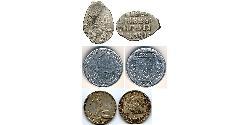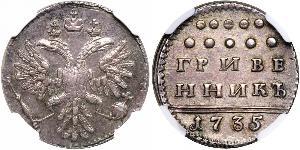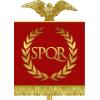2 Kopeck Russian Empire (1720-1917) Copper Alexander II of Russia ...
6
coins in the group
(800 X 403pixels, file size: ~84K)
Posted by: anonymous 2016-03-20
POLAND; Monety zaboru rosyjskiego - Mikołaj I 1825-1855 i Aleksander II 1855-1881. 2 kopiejki 1856, Warszawa, odmiana z cyfrą nominału zamkniętą, Plage 486, Bitkin 464, patyna - GRADE: II
(925 X 457pixels, file size: ~134K)
Posted by: anonymous 2015-11-15
THE SINCONA COLLECTION PART 4 Nicholas I 1850 2 Kopecks 1850, Ekaterinburg Mint. 10.25 g. Bitkin 596. GM 35.12. Brilliant uncirculated. 2 копеек 1850, Екатеринбургский МД. 10.25 г. Биткин 596. ГМ 35,12. Безупречно превосходное. Collector’s note: “Unc toned” Заметки коллекционера: «Не были в обр ...
(1037 X 490pixels, file size: ~110K)
Posted by: anonymous 2015-06-12
Urcaquary 1858, Russia, Emperor Nicholas I. Copper 2 Kopeks Coin. Warsaw mint! Mint Year: 1858 Denomination: 2 Kopeks Reference: KM-150.3. R! Mint Place: Warsaw (B-M) Condition: Two scratches and a dig in obverse, otherwise VF. Material: Copper Weight: 10.07gm Diameter: 28mm O ...
(1605 X 800pixels, file size: ~286K)
Posted by: anonymous 2015-02-27
Russia. Pattern 2 Kopecks, 1863-ЕМ. B-142; KM-PN131 (Pn129). Copper. Brussels mint. Alexander II. NGC graded Proof 64. Estimated Value $1,000-UP. Categories: World Crowns and Minors
Related online coin collections

spa1 » Копейки - старые и новые (57 coins)
Красивые копейки разных времен - Древняя Русь, Российская Империя, СССР, Россия, Украина, Польша, Молдавия. Интересно, что в древние времена даже копейки были серебряными а сегодня даже рубли из дешевых металлов. Может быть поэтому раньше ин ...
You may be interested in following coins
2024-04-26
- Historical Coin Prices
2024-04-26
- Historical Coin Prices
You may be interested in ...

-500-250-XN_BwcI0RBUAAAEoLcag3tS7.jpg)
-300-150-2X0KX9ISgEEAAAFTtg9rNpKV.jpg)
-300-150-IPsKbzbij2gAAAFRbe9auwl3.jpg)
-300-150-1ScKbzbicZ4AAAFNeyJdvgZe.jpg)
-300-150-ozYKbzbiTfoAAAFLspOjlszT.jpg)
-300-150-XN_BwcI0RBUAAAEoLcag3tS7.jpg)
-300-150-R1rBwcI0Vf8AAAEoJqZ7Lrtq.jpg)













